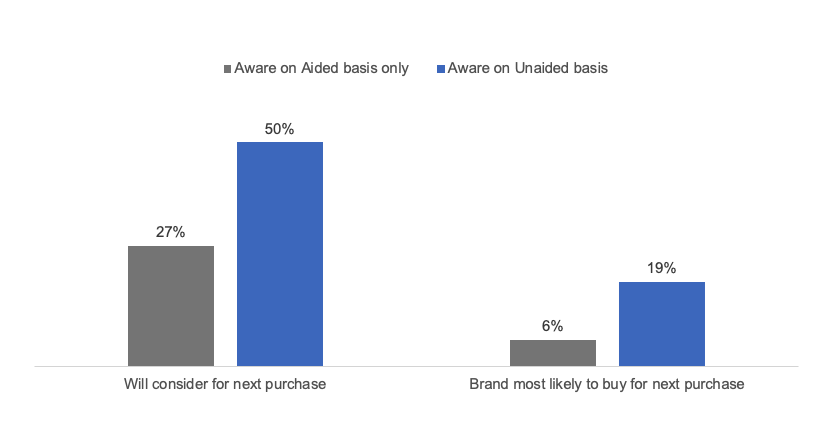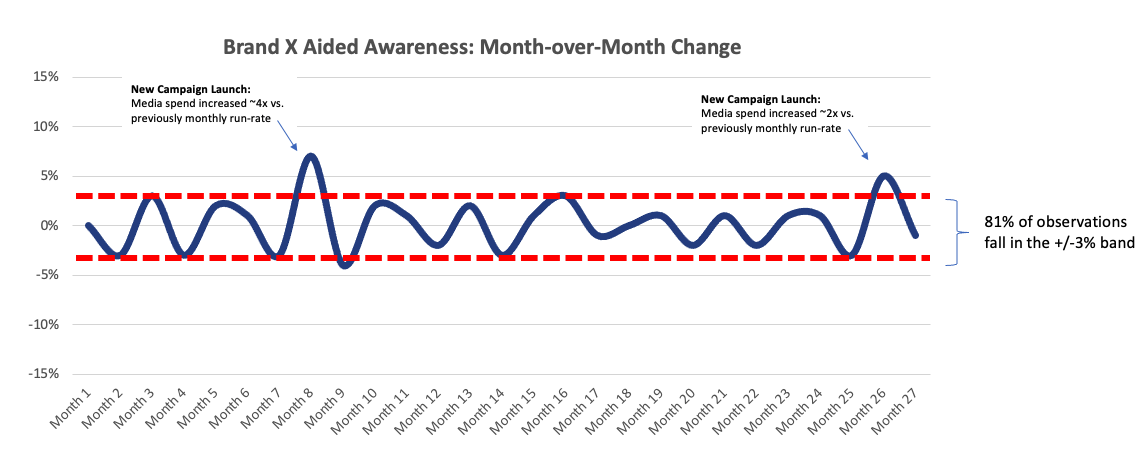
The Path Toward Setting More Effective Awareness Goals
Brand awareness consistently comes up as the most important measure any time we conduct brand tracking research on behalf of our clients. There are clear reasons for this. First, awareness converts. That is, for a consumer to consider your brand and ultimately purchase it, they have to first be aware you exist. Secondly, marketers tend to have “harder” metrics available to them on how the brand is performing lower in the conversion funnel whereas there are few reliable proxies for awareness.
Given the importance of awareness, it is critical for marketers to set a valid goal and confidently measure success toward that goal over time. This is often easier said than done; however, as it is not uncommon for marketers to set lofty goals or unrealistic expectations of what an awareness measure can achieve. Read on for a few tips on how to more effectively set awareness goals.
Tip #1: Ensure your top of funnel goal maps to lower funnel outcomes
This should seem obvious but it is not uncommon for marketers to overlook the simple fact that what you bring into the top of the funnel permeates all the way to the bottom of the funnel. A handy metric to leverage here is your “awareness-to-purchase ratio.” You can easily derive this measure by dividing the percent aware of your brand by the percent who purchase. We recently conducted an exercise with a client and they were surprised to hear that the lofty awareness goal they were signing up for was basically akin to seeing a $12 ROI on their marketing spend based on the expected level of sales it would produce (not to mention they’d probably run out of stock!). You can also do this exercise in reverse. That is, if you have a sales goal, simply work your way back up the funnel by using the awareness-to-purchase ratio to estimate the awareness level you must achieve to meet this goal. While the approach outlined here is not intended to be rocket science, it is sometimes helpful to do some “back of the napkin math” as a reality check.
Tip #2: Favor unaided awareness over aided
There is often a default bias to set awareness goals on an aided basis without much thought. This preference for aided over unaided awareness may be driven by marketers’ desire to tout a larger number. Or perhaps it is to make sure they are getting full credit for their brand-building efforts. Either way, in our experience unaided awareness tends to be more responsive, tracking more closely with marketing activity and sales trends. We have also seen in our own trackers as well as syndicated studies that it is more of a harbinger for converting a purchase. Consumers who are aware of a brand on an unaided basis are far more likely to consider it compared to those only aware on an aided basis. You can see this dynamic at play below for one of our clients. Those who were aware of the brand on an unaided basis are 2x more likely to consider purchasing and 3x times more likely to say it is the most likely brand they will buy.

Tip #3: Be cognizant of the statistical power of your tracker
While this suggestion is perhaps both a bit basic and nerdy at the same time, it is important to consider the statistical power of your study. It has a margin of error based on your sample size and if you set your awareness growth goal lower than your margin of error, you are basically setting it at +0%. Or, if you have immense statistical power yielding a narrow margin of error, setting a growth goal of say +5% may prove too ambitious. While we always caution our clients to focus on managerial significance and not use statistical significance as a crutch, there is value in understanding the sensitivity of your measurement when setting an awareness goal.
Tip #4: Survey related awareness measures are prone to volatility
I will venture to guess that we have all taken a ride on the roller coaster of emotions over awareness trends before. One month, our brand awareness magically goes up noticeably; however, this emotional high is short-lived when the next month’s reading comes in and it drops lower than it was previously. Unfortunately, this is just the nature of the beast when dealing with survey-based tracking methods. My advice here would be a) don’t let your emotions get the best of you on a month-to-month basis and b) if you have long-running awareness trends, put that data to good use. The chart below shows how we did that for one of our clients. We plotted the month-over-month changes over that time frame to establish what the “rhythm” of that trend looked like. The good news in this case was that the only periods where we bucked that trend, in a positive way, aligned to new campaign launches.

Perhaps one day, a new “holy grail” of awareness measurement will emerge. Until then, we must remain clear-eyed about what a survey-based awareness measure can achieve. Otherwise, we risk signing up for a measure we can’t be held to or reasonably reach.
This is not an advertisement, and solely reflects the views and opinions of the author. This website and its commentaries are not designed to provide legal or other advice and you should not take, or refrain from taking, action based on its content.

